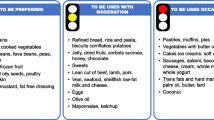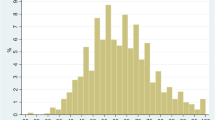Abstract
The present study was done to evaluate the effect of short-term dietary therapy on 148 dyslipidaemic children (24 familial hypercholesterolaemia, 105 non-familial hypercholesterolaemia and 19 hypertriglyceridaemia), detected by mass screening in children at 18 months of age. In the model diet used for treatment, 15% of the total calories were obtained from protein, 27% from fat and 57% from carbohydrate. Cholesterol intake was set at <200 mg/day and the ratio of polyunsaturated to saturated fatty acid (P/S ratio) was 1.2. When compared to the composition of the diet ingested by the dyslipidaemic children, only the P/S ratio changed from 0.7 to 1.2. During 12 months treatment, levels of total cholesterol, low density lipoproteins cholesterol and apoB decreased by 10%–15% in children with familial and non-familial hypercholesterolaemia. There was no significant change in the levels of high density lipoproteins. In 19 children with hypertriglyceridaemia, the intake of carbohydrate was limited to 55% of the total calories consumed and after 12 months of treatment, triglyceride levels reverted to normal. Throughout the study period, apprimately 70% of the children on this dietary therapy were seen in our clinics every 3–6 months and physical development was within normal ranges. These results, taken together, indicate that dietary therapy can be effective for correcting dyslipidaemia, even in young children.
Similar content being viewed by others
Abbreviations
- ACHD:
-
atherosclerotic coronary heart disease
- FH:
-
familial hypecholesterolaemia
- HDL:
-
high density lipoprotein
- HDL-C:
-
high density lipoprotein cholesterol
- H-TG:
-
hypertriglyceridaemia
- LDL-C:
-
low density lipoprotein cholesterol
- NCEP:
-
the national cholesterol education program in USA
- P/S ratio:
-
the ratio of polyunsaturated to saturated fatty acid
- TC:
-
total cholesterol
- TG:
-
triglyceride
- non-FH:
-
non-familial hypercholesterolaemia
References
American Academy of Pediatrics, Committee on Nutrition (1985) Pediatric Nutrition Handbook. 235–246
American Academy of Pediatrics, Committee on Nutrition (1989) Indications for cholesterol testing in children. Pediatrics 83:141–142
Holman RL, McGill HC, Strong JP, et al. (1958) The natural history of atherosclerosis. Am J Pathol 34:209–235
Nakamura R, Ohta T, Migita M, et al (1992) Mass screening to identify babies with dyslipoproteinemia by measuring the levels of apoA-I, apoB and the ratio of apoB to apoA-I on dried blood spots. Screening 1:17–25
NCEP Expert Panel on Blood Cholesterol Levels in Children and Adolescents (1992) National cholesterol education program (NCEP): Highlight of the report of the expert panel on blood cholesterol levels in children and adolescents. Pediatrics 89:495–501
Ohkuni M (1990) Pediatric aspect for risk factor against coronary heart diseases. (in Japanese) Pediatr Prac 53:238–242
Ohta T, Matsuda I (1981)Lipid and apolipoprotein levels in patients with nephrotic syndrome. Clin Chim Acta 117:133–143
Ohta T, Hattori S, Murakami M,et al (1989) Age- and sex-related differences in lipoproteins containing apoprotein A-I. Arteriosclerosis. 9:90–95
Pathobiological Determination of Atherosclerosis in Youth Research Group (1990). Relationship of atherosclerosis in young men to serum lipoprotein cholesterol concentrations and smoking. JAMA 264:3018–3024
Quivers ES, Driscoll DJ, Garvey CD, et al (1992) Variability in response to a low-fat, low-cholesterol diet in children with elevated low density lipoprotein cholesterol levels. Pediatrics 89:925–929
Sekimoto H, Goto Y, Goto Y, et al (1983) Changes of serum total cholesterol and triglyceride levels in normal subjects in Japan in the past twenty years. Jpn Circ J 47:1351–1358
Strong JP, Eggen DA, Oalmann MC, et al (1973) Pathology and epidemiology of atherosclerosis. J Am Diet Assoc 62: 262–268
Author information
Authors and Affiliations
Rights and permissions
About this article
Cite this article
Ohta, T., Nakamura, R., Ikeda, Y. et al. Follow up study on children with dyslipidaemia detected by mass screening at 18 months of age: effect of 12 months dietary treatment. Eur J Pediatr 152, 939–943 (1993). https://doi.org/10.1007/BF01957537
Received:
Accepted:
Issue Date:
DOI: https://doi.org/10.1007/BF01957537




